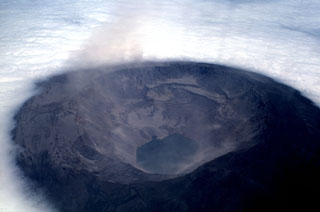Report on Fernandina (Ecuador) — 3 April-9 April 2024
Smithsonian Institution / US Geological Survey
Weekly Volcanic Activity Report, 3 April-9 April 2024
Managing Editor: Sally Sennert.
Please cite this report as:
Global Volcanism Program, 2024. Report on Fernandina (Ecuador) (Sennert, S, ed.). Weekly Volcanic Activity Report, 3 April-9 April 2024. Smithsonian Institution and US Geological Survey.
Fernandina
Ecuador
0.37°S, 91.55°W; summit elev. 1476 m
All times are local (unless otherwise noted)
Instituto Geofísico-Escuela Politécnica Nacional (IG-EPN) reported that during 2 March-1 April an estimated 44 million cubic meters of lava had erupted at Fernandina, making the current eruption the largest in the last 15 years, surpassed only by the 2009 eruption. Fissure 13, located just below the crater rim on the upper SE flank, continued to be active during 2-9 April; the rate of lava effusion was about five cubic meters per second at least through 4 April, though the advancement rate of the distal end of the lava flow was variable. Sulfur dioxide emissions were generally at moderate levels, fluctuating between about 100 and 1,000 tons per day, though emissions were as high as around 1,650 tons per day on 4 April. Daily thermal anomalies over the lava flow continued to be detected and were variable in both number and intensity. The lava flows continued to advance down the flank and by 4 April were about 13.2 km long and about 1.3 km from the coastline. Based on observations from the Dirección del Parque Nacional Galápagos, the Ministerio del Ambiente, and Agua y Transición Ecológica the flows reached the ocean on 7 April. An 8 April satellite image showed plumes of gas and steam rising from the ocean entry.
Geological Summary. Fernandina, the most active of Galápagos volcanoes and the one closest to the Galápagos mantle plume, is a basaltic shield volcano with a deep 5 x 6.5 km summit caldera. The volcano displays the classic "overturned soup bowl" profile of Galápagos shield volcanoes. Its caldera is elongated in a NW-SE direction and formed during several episodes of collapse. Circumferential fissures surround the caldera and were instrumental in growth of the volcano. Reporting has been poor in this uninhabited western end of the archipelago, and even a 1981 eruption was not witnessed at the time. In 1968 the caldera floor dropped 350 m following a major explosive eruption. Subsequent eruptions, mostly from vents located on or near the caldera boundary faults, have produced lava flows inside the caldera as well as those in 1995 that reached the coast from a SW-flank vent. Collapse of a nearly 1 km3 section of the east caldera wall during an eruption in 1988 produced a debris-avalanche deposit that covered much of the caldera floor and absorbed the caldera lake.
Source: Instituto Geofísico-Escuela Politécnica Nacional (IG-EPN)

